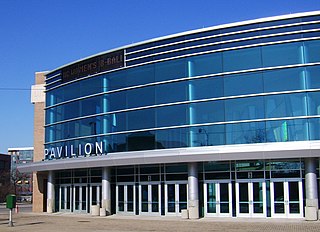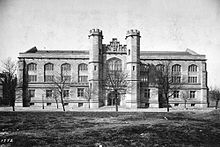
The Big Ten Conference is the oldest Division I collegiate athletic conference in the United States. Founded as the Intercollegiate Conference of Faculty Representatives in 1896, it predates the founding of its regulating organization, the NCAA. It is based in the Chicago area in Rosemont, Illinois. For many decades the conference consisted of 10 prominent universities, which accounts for its name. As of August 2024, it consists of 18 member institutions and 2 affiliate institutions. The conference competes in the NCAA Division I and its football teams compete in the Football Bowl Subdivision (FBS), formerly known as Division I-A, the highest level of NCAA competition in that sport.

NCAA Division I (D-I) is the highest level of intercollegiate athletics sanctioned by the National Collegiate Athletic Association (NCAA) in the United States, which accepts players globally. D-I schools include the major collegiate athletic powers, with large budgets, more elaborate and nicer facilities and a few more athletic scholarships than Divisions II and III as well as many smaller schools committed to the highest level of intercollegiate competition.

The Illinois Fighting Illini are the intercollegiate athletic teams that represent the University of Illinois Urbana-Champaign. The university offers 10 men's and 11 women's varsity sports.

Credit Union 1 Arena is a multi-purpose arena located at 525 S. Racine Avenue on the Near West Side in Chicago, Illinois. It opened in 1982.

The UCLA Bruins are the athletic teams that represent the University of California, Los Angeles. The Bruin men's and women's teams participate in NCAA Division I as part of the Pac-12 Conference and the Mountain Pacific Sports Federation (MPSF). For football, they are in the Football Bowl Subdivision of Division I. UCLA is second to only Stanford University as the school with the most NCAA team championships at 123 NCAA team championships. UCLA offers 11 varsity sports programs for men and 14 for women.

The Clemson Tigers are the athletic teams that represent Clemson University, located in Clemson, South Carolina. They compete as a member of the National Collegiate Athletic Association (NCAA) Division I level. Clemson competes for and has won multiple NCAA Division I national championships in football, men's soccer, and men's golf. The Clemson Tigers field twenty-one athletic teams, nine men's and twelve women's, across thirteen sports.

The BYU Cougars are the intercollegiate athletic teams that represent Brigham Young University (BYU), located in Provo, Utah. BYU fields 21 National Collegiate Athletic Association (NCAA) varsity athletic teams. They are a member of the Big 12 Conference for all sports except men's volleyball which is a member of the Mountain Pacific Sports Federation. They were a member of the West Coast Conference from 2011 to 2022. From 1999 to 2011 they were a member of the Mountain West Conference and before the formation of the MW, the Cougars competed in the Rocky Mountain Athletic Conference, the Mountain States Conference, and the Western Athletic Conference. BYU officially joined the Big 12 Conference on July 1, 2023.

The UIC Flames are the intercollegiate athletic teams that represent the University of Illinois Chicago, located in Chicago, Illinois, in intercollegiate sports as a member of the Division I level of the National Collegiate Athletic Association (NCAA), primarily competing in the Missouri Valley Conference (MVC) since the 2022–23 academic year. The Flames previously competed in the D-I Horizon League from 1994–95 to 2021–22; in the D-I Mid-Continent Conference from 1982–83 to 1993–94; as an NCAA D-I Independent during the 1981–82 school year; and in the Chicagoland Collegiate Athletic Conference (CCAC) of the National Association of Intercollegiate Athletics (NAIA) from 1949–50 to about 1980–81. Michael Lipitz joined UIC in October 2019 as the athletic director.

The Loyola Ramblers men's basketball team represents Loyola University Chicago in Chicago, Illinois. The Ramblers participate as members of the Atlantic 10 Conference. The Ramblers had joined the Missouri Valley Conference in 2013, and stayed until 2022. Prior to 2013, the team had spent 34 seasons as a charter member of the Horizon League.

The NCAA Men's Gymnastics Championships are a gymnastics competition held each year to determine the best men's college gymnastics team. All schools compete in one National Collegiate division because only 15 schools sponsor NCAA men's gymnastics teams. Three of the 15 teams are not in Division I: Greenville University, Simpson College, Springfield College.

The NCAA women's gymnastics tournament is an annual gymnastics competition to determine the best collegiate women's gymnastics team in the country. Unlike most NCAA sports, the women's gymnastics championship is not separated into divisions and uses a single National Collegiate tournament instead.
Frank K. Schmitz was an American trampoline gymnast who won four individual NCAA titles and a silver medal at the 1965 Trampoline World Championships.
William Henry Roetzheim, Jr. was an American gymnast, collegiate coach, and administrator. He competed at the 1948 Summer Olympics and the 1952 Summer Olympics. Roetzheim won gold at the 1951 Pan American Games, and he was also an army veteran who served in the Korean War.

The 1939 NCAA gymnastics championships were contested at the second annual National Collegiate Athletic Association-sanctioned men's gymnastics championships to determine the team and individual national champions of men's collegiate gymnastics among its member programs in the United States.

The 1940 NCAA gymnastics championships were contested at the third annual National Collegiate Athletic Association-sanctioned men's gymnastics championships to determine the team and individual national champions of men's collegiate gymnastics among its member programs in the United States.

The 1941 NCAA gymnastics championships were contested at the fourth annual National Collegiate Athletic Association-sanctioned men's gymnastics championships to determine the team and individual national champions of men's collegiate gymnastics among its member programs in the United States.

The 1942 NCAA gymnastics championships were contested at the fifth annual National Collegiate Athletic Association-sanctioned men's gymnastics championships to determine the team and individual national champions of men's collegiate gymnastics among its member programs in the United States.

The 1948 NCAA gymnastics championships were contested at the sixth annual National Collegiate Athletic Association-sanctioned men's gymnastics championships to determine the team and individual national champions of men's collegiate gymnastics among its member programs in the United States. Due to the interruption of sporting events caused by World War II, these were the first championships held since 1942.

The 1949 NCAA gymnastics championships were contested at the seventh annual National Collegiate Athletic Association-sanctioned men's gymnastics championships to determine the team and individual national champions of men's collegiate gymnastics among its member programs in the United States.
The 1950 NCAA gymnastics championships were contested at the eighth annual National Collegiate Athletic Association-sanctioned men's gymnastics championships to determine the team and individual national champions of men's collegiate gymnastics among its member programs in the United States.














